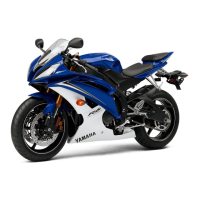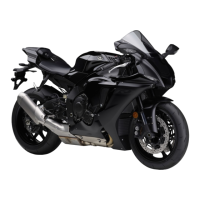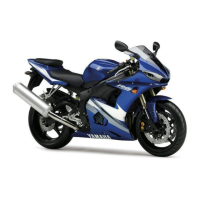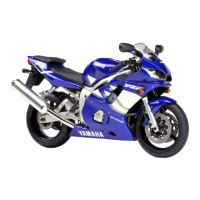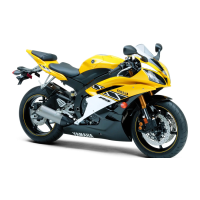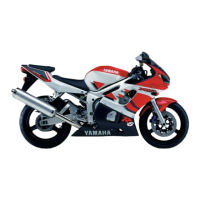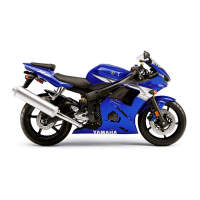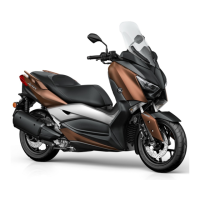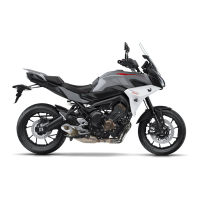Do you have a question about the Yamaha YZF-R6 2017 and is the answer not in the manual?
Owner's responsibilities for safe operation and fundamental safe riding practices.
Recommendations for wearing appropriate safety gear while riding the motorcycle.
Information on the dangers of carbon monoxide poisoning from engine exhaust.
Guidelines for safely adding cargo or accessories to the motorcycle.
Advice on using genuine Yamaha accessories versus aftermarket modifications.
Diagram illustrating key components visible from the left side of the motorcycle.
Diagram illustrating key components visible from the right side of the motorcycle.
An introduction to the motorcycle's controls and instrument panel layout.
Explanation of the electronically controlled engine performance system with mode selections.
How the traction control system helps maintain grip on slippery surfaces.
Information on the system allowing clutch-less, full-throttle upshifts.
Operation of the main switch for ignition, lighting, and steering lock.
Description and function of switches located on the left and right handlebars.
Explanation of various indicator lights and warning lights on the instrument panel.
Overview of the meter unit and its various display capabilities.
Operation and adjustment of the clutch lever, shift pedal, and brake lever/pedal.
Details on the Anti-lock Brake System's function and operation.
Information on the fuel tank cap, fuel type, capacity, and hoses.
Procedures for removing and installing the passenger and rider seats.
How to adjust the front fork's spring preload and damping settings.
How to adjust the rear shock absorber's spring preload and damping settings.
Checks for fuel level, line, tank hoses, and potential leaks.
Checks for engine oil and coolant levels, and potential system leaks.
Checks for brake operation, fluid level, and pad wear for front and rear brakes.
Checks for clutch operation, cable lubrication, and lever free play.
Checks for smooth throttle operation, grip free play, and cable condition.
Checks for drive chain slack, condition, and wheel/tire integrity.
Checks for smooth operation of pedals, levers, and the sidestand.
Checks for instrument, lights, switches operation, and chassis fastener tightness.
Includes lean angle sensor, engine auto-stop system, and familiarization.
Step-by-step instructions for starting the motorcycle engine safely.
Guidance on proper gear shifting for acceleration and deceleration.
Recommendations for the initial engine break-in period to ensure longevity.
Instructions for safely parking the motorcycle, considering hot components.
Importance of periodic inspection, adjustment, and lubrication for safety and efficiency.
Description and location of the tools provided with the motorcycle.
Maintenance schedule and procedures for the emission control system.
Comprehensive chart detailing routine maintenance and lubrication intervals.
Procedures for removing and reinstalling body panels for maintenance access.
Instructions for checking, cleaning, and replacing spark plugs.
Inspection of the evaporative emission control canister and hoses.
Procedures for checking engine oil level and changing oil/filter.
How to check coolant level and procedures for changing coolant.
Instructions for replacing the air filter element.
Procedures for checking engine idling speed and throttle grip free play.
Importance and procedure for checking and adjusting valve clearance.
General information on tires and required checks before riding.
Importance and procedure for checking and adjusting tire air pressure.
Checking wheel rims for damage, bends, and ensuring proper balancing.
How to check and adjust the clutch lever's free play.
How to check for and adjust the brake lever's free play.
Function and servicing of brake light activation switches.
How to inspect front and rear brake pads for wear using indicators.
Procedure for checking the brake fluid level in reservoirs.
Intervals and procedures for changing brake fluid and replacing seals/hoses.
How to check and adjust the drive chain slack for optimal performance.
Procedures for cleaning and lubricating the drive chain.
Checking and lubricating all control cables for smooth operation.
Lubricating the throttle grip and cable for smooth throttle response.
Lubricating the pivots of brake/shift pedals and brake/clutch levers.
Lubricating the sidestand pivot and swingarm pivots.
Inspecting the front fork for damage and checking its operational smoothness.
Checking steering bearings for wear or looseness.
Inspecting front and rear wheel bearings for play or rough operation.
Details on the battery type, location, and basic checks.
Procedures for charging and storing the battery properly.
Instructions for identifying and replacing blown fuses.
Information on LED lights and troubleshooting non-operational lights.
Procedure for replacing the license plate light bulb.
Using maintenance stands for procedures requiring the vehicle to be upright.
General guidance on diagnosing and resolving common motorcycle problems.
Diagnostic flowcharts for starting issues and poor engine performance.
Steps to diagnose and resolve engine overheating issues.
Special care instructions for parts with a matte finish to prevent damage.
Basic guidelines for cleaning the motorcycle and maintaining its appearance.
Specific instructions for cleaning the windshield and titanium muffler.
Procedures for short-term and long-term storage to protect the motorcycle.
Key physical dimensions and weight specifications of the motorcycle.
Details on engine type, displacement, bore, stroke, and oil requirements.
Information on recommended fuel, tank capacity, and coolant quantity.
Specs for air filter, spark plug, clutch, ignition, charging, and battery systems.
Details on gear ratios, frame type, caster angle, and trail.
Information on tire sizes, types, wheel specs, and air pressure.
Details on brake system types and suspension components.
Information on the electrical system voltage and components.
Details on light types (LED) and specifications for all vehicle fuses.
Recording VIN, engine serial number, model label, and key ID for registration.
Location and purpose of the emissions control information label.
Location of diagnostic port and how the ECU records vehicle data.
Procedure for reporting potential safety defects to NHTSA and Yamaha.
Prohibitions against tampering with noise control systems on the vehicle.
A chart for logging service intervals and work performed.
Information regarding the manufacturer's limited warranty coverage and terms.
Answers to common warranty questions and contact information for service.
Information about the optional extended service plan for added protection.
Owner's responsibilities for safe operation and fundamental safe riding practices.
Recommendations for wearing appropriate safety gear while riding the motorcycle.
Information on the dangers of carbon monoxide poisoning from engine exhaust.
Guidelines for safely adding cargo or accessories to the motorcycle.
Advice on using genuine Yamaha accessories versus aftermarket modifications.
Diagram illustrating key components visible from the left side of the motorcycle.
Diagram illustrating key components visible from the right side of the motorcycle.
An introduction to the motorcycle's controls and instrument panel layout.
Explanation of the electronically controlled engine performance system with mode selections.
How the traction control system helps maintain grip on slippery surfaces.
Information on the system allowing clutch-less, full-throttle upshifts.
Operation of the main switch for ignition, lighting, and steering lock.
Description and function of switches located on the left and right handlebars.
Explanation of various indicator lights and warning lights on the instrument panel.
Overview of the meter unit and its various display capabilities.
Operation and adjustment of the clutch lever, shift pedal, and brake lever/pedal.
Details on the Anti-lock Brake System's function and operation.
Information on the fuel tank cap, fuel type, capacity, and hoses.
Procedures for removing and installing the passenger and rider seats.
How to adjust the front fork's spring preload and damping settings.
How to adjust the rear shock absorber's spring preload and damping settings.
Checks for fuel level, line, tank hoses, and potential leaks.
Checks for engine oil and coolant levels, and potential system leaks.
Checks for brake operation, fluid level, and pad wear for front and rear brakes.
Checks for clutch operation, cable lubrication, and lever free play.
Checks for smooth throttle operation, grip free play, and cable condition.
Checks for drive chain slack, condition, and wheel/tire integrity.
Checks for smooth operation of pedals, levers, and the sidestand.
Checks for instrument, lights, switches operation, and chassis fastener tightness.
Includes lean angle sensor, engine auto-stop system, and familiarization.
Step-by-step instructions for starting the motorcycle engine safely.
Guidance on proper gear shifting for acceleration and deceleration.
Recommendations for the initial engine break-in period to ensure longevity.
Instructions for safely parking the motorcycle, considering hot components.
Importance of periodic inspection, adjustment, and lubrication for safety and efficiency.
Description and location of the tools provided with the motorcycle.
Maintenance schedule and procedures for the emission control system.
Comprehensive chart detailing routine maintenance and lubrication intervals.
Procedures for removing and reinstalling body panels for maintenance access.
Instructions for checking, cleaning, and replacing spark plugs.
Inspection of the evaporative emission control canister and hoses.
Procedures for checking engine oil level and changing oil/filter.
How to check coolant level and procedures for changing coolant.
Instructions for replacing the air filter element.
Procedures for checking engine idling speed and throttle grip free play.
Importance and procedure for checking and adjusting valve clearance.
General information on tires and required checks before riding.
Importance and procedure for checking and adjusting tire air pressure.
Checking wheel rims for damage, bends, and ensuring proper balancing.
How to check and adjust the clutch lever's free play.
How to check for and adjust the brake lever's free play.
Function and servicing of brake light activation switches.
How to inspect front and rear brake pads for wear using indicators.
Procedure for checking the brake fluid level in reservoirs.
Intervals and procedures for changing brake fluid and replacing seals/hoses.
How to check and adjust the drive chain slack for optimal performance.
Procedures for cleaning and lubricating the drive chain.
Checking and lubricating all control cables for smooth operation.
Lubricating the throttle grip and cable for smooth throttle response.
Lubricating the pivots of brake/shift pedals and brake/clutch levers.
Lubricating the sidestand pivot and swingarm pivots.
Inspecting the front fork for damage and checking its operational smoothness.
Checking steering bearings for wear or looseness.
Inspecting front and rear wheel bearings for play or rough operation.
Details on the battery type, location, and basic checks.
Procedures for charging and storing the battery properly.
Instructions for identifying and replacing blown fuses.
Information on LED lights and troubleshooting non-operational lights.
Procedure for replacing the license plate light bulb.
Using maintenance stands for procedures requiring the vehicle to be upright.
General guidance on diagnosing and resolving common motorcycle problems.
Diagnostic flowcharts for starting issues and poor engine performance.
Steps to diagnose and resolve engine overheating issues.
Special care instructions for parts with a matte finish to prevent damage.
Basic guidelines for cleaning the motorcycle and maintaining its appearance.
Specific instructions for cleaning the windshield and titanium muffler.
Procedures for short-term and long-term storage to protect the motorcycle.
Key physical dimensions and weight specifications of the motorcycle.
Details on engine type, displacement, bore, stroke, and oil requirements.
Information on recommended fuel, tank capacity, and coolant quantity.
Specs for air filter, spark plug, clutch, ignition, charging, and battery systems.
Details on gear ratios, frame type, caster angle, and trail.
Information on tire sizes, types, wheel specs, and air pressure.
Details on brake system types and suspension components.
Information on the electrical system voltage and components.
Details on light types (LED) and specifications for all vehicle fuses.
Recording VIN, engine serial number, model label, and key ID for registration.
Location and purpose of the emissions control information label.
Location of diagnostic port and how the ECU records vehicle data.
Procedure for reporting potential safety defects to NHTSA and Yamaha.
Prohibitions against tampering with noise control systems on the vehicle.
A chart for logging service intervals and work performed.
Information regarding the manufacturer's limited warranty coverage and terms.
Answers to common warranty questions and contact information for service.
Information about the optional extended service plan for added protection.
| Bore x Stroke | 67.0mm x 42.5mm |
|---|---|
| Compression Ratio | 13.1:1 |
| Fuel Delivery | Fuel injection with YCC-T and YCC-I |
| Ignition | TCI: Transistor Controlled Ignition |
| Final Drive | Chain |
| Front Brakes | Dual 320mm hydraulic disc; ABS |
| Rear Brakes | 220mm hydraulic disc; ABS |
| Front Tire | 120/70ZR17 |
| Rear Tire | 180/55ZR17 |
| Length | 80.3 in |
| Width | 27.4 in |
| Height | 43.1 in |
| Seat Height | 33.5 in |
| Wheelbase | 54.1 in |
| Rake (Caster Angle) | 24.0° |
| Trail | 3.8 in |
| Fuel Capacity | 4.6 gal |
| Wet Weight | 419 lb |
| Engine Type | Liquid-cooled inline 4-cylinder, DOHC, 16 valves |
| Transmission | 6-speed |
| Front Suspension | 43mm inverted fork, fully adjustable; 4.7-in travel |
